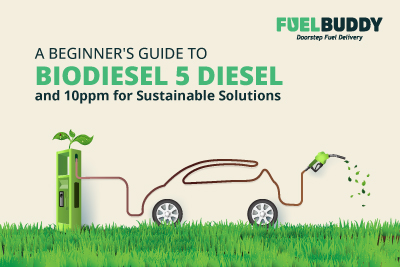As the world strives for eco-friendly alternatives in every sector, transportation/ Fleet of vehicles is no exception. Biodiesel, particularly the blend Biodiesel 5 Diesel 10ppm, offers a promising solution to reduce carbon footprints and promote sustainable practices in the diesel industry. In this blog post, we’ll guide you through the steps to get started with Biodiesel 5 Diesel and 10ppm for a cleaner, greener tomorrow.
Understanding Biodiesel 5 Diesel and 10ppm:
Biodiesel 5 Diesel 10ppm signifies a biodiesel blend containing 5% biodiesel and adheres to ultra-low sulfur diesel (ULSD) standards, with a sulfur content of 10 parts per million (ppm). This blend brings environmental benefits and maintains the high performance associated with diesel fuel.
Step 1: Grasp the Basics of Biodiesel:
Before diving into the world of Biodiesel 5-diesel 10ppm, it’s essential to comprehend what biodiesel is and its advantages over traditional diesel. Biodiesel is derived from renewable sources like vegetable oils, animal fats, or recycled cooking oils. Research its environmental impact, engine compatibility, and how it aligns with your sustainability goals.
Step 2: Verify Compatibility and Regulations:
Ensure that your diesel vehicle is compatible with biodiesel blends. Many modern diesel engines are designed to accommodate biodiesel, but checking the manufacturer’s guidelines is crucial. Additionally, be aware of any local or national regulations regarding biodiesel use, including quality standards.
Step 3: Find a Reliable Supplier:
Identify a trustworthy supplier for Biodiesel 5 Diesel and 10ppm in your vicinity. This may involve reaching out to local fuel distributors, and biodiesel producers, or exploring online resources. Confirm that the biodiesel meets necessary quality standards and certifications to guarantee a seamless and sustainable fueling experience.
Step 4: Upgrade Fuel System Components:
Consider upgrading specific fuel system components to ensure optimal performance and longevity of your engine. Biodiesel possesses different properties than traditional diesel, and some older fuel systems may need modifications. Consult with a qualified mechanic to determine if any adjustments are necessary for your vehicle.
Step 5: Gradual Transition with Low Blends:
If you’re new to biodiesel, initiate the transition with lower blends, such as B5 (5% biodiesel). Gradually increasing the blend allows you to monitor any potential impacts on engine performance and fuel efficiency, providing a smoother transition to sustainable fuel alternatives.
Step 6: Regular Monitoring and Evaluation:
Consistently monitor your vehicle’s performance, fuel efficiency, and emissions when using Biodiesel 5 Diesel and 10ppm. Keep records of any changes in engine operation and consult with professionals if needed. This proactive approach will enable you to assess the long-term benefits and performance of biodiesel.
Embarking on the journey of using Biodiesel 5 Diesel and 10ppm is a positive stride towards sustainable and eco-conscious practices. By understanding biodiesel basics, ensuring compatibility, finding a reliable supplier, and gradual adoption, you contribute to cleaner air, reduced emissions, and a more sustainable environment. Embrace biodiesel as a feasible and eco-friendly alternative, steering us towards a future where transportation aligns with the principles of environmental responsibility. Visit www.fuelbuddy.ae







